County town in England
| Trowbridge | |
|---|---|
| County town | |
 Trowbridge Town Hall, seen from Fore Street Trowbridge Town Hall, seen from Fore Street | |
 | |
| Population | 37,169 (2021 Census) |
| OS grid reference | ST856579 |
| Unitary authority | |
| Ceremonial county | |
| Region | |
| Country | England |
| Sovereign state | United Kingdom |
| Post town | TROWBRIDGE |
| Postcode district | BA14 |
| Dialling code | 01225 |
| Police | Wiltshire |
| Fire | Dorset and Wiltshire |
| Ambulance | South Western |
| UK Parliament | |
| Website | Town Council |
| 51°19′12″N 2°12′29″W / 51.320°N 2.208°W / 51.320; -2.208 | |
Trowbridge (/ˈtroʊbrɪdʒ/ TROH-brij) is the county town of Wiltshire, England; situated on the River Biss in the west of the county, close to the border with Somerset. The town lies 8 miles (13 km) south-east of Bath, 31 miles (50 km) south-west of Swindon and 20 miles (32 km) south-east of Bristol. The parish had a population of 37,169 in 2021.
Long a market town, the Kennet and Avon canal to the north of Trowbridge played an instrumental part in the town's development, as it allowed coal to be transported from the Somerset Coalfield; this marked the advent of steam-powered manufacturing in woollen cloth mills. The town was the foremost centre of woollen cloth production in south west England in the late 18th and early 19th centuries, by which time it held the nickname "The Manchester of the West".
The parish encompasses the settlements of Longfield, Lower Studley, Upper Studley, Studley Green and Trowle Common.
History
Toponymy
The origin of the name Trowbridge is uncertain; one source claims derivation from treow-brycg, meaning "Tree Bridge", referring to the first bridge over the Biss, while another states the true meaning is the bridge by Trowle, the name of a hamlet and a common to the west of the town. On John Speed's map of Wiltshire (1611), the name is spelt Trubridge.
Early history
In the 10th century, written records and architectural ruins begin marking Trowbridge's existence as a village. In the 1086 Domesday Book the village of Straburg, as Trowbridge was then known, was recorded as having 24 households, well endowed with land, particularly arable ploughlands, and rendering 8 pounds sterling to its feudal lord a year. Its feudal lord was an Anglo-Saxon named Brictric, who was the largest landowner in Wiltshire.
Castle
Main article: Trowbridge CastleThe first mention of Trowbridge Castle was in 1139 when it was besieged. It was no longer in military use by the 14th century and by the 16th only ruins remained. The castle is thought to have been a motte-and-bailey castle, and its influence can still be seen in the town today. Fore Street follows the path of the castle ditch, and town has a Castle Street and the Castle Place Shopping Centre.
It is likely the Castle was built by Humphrey I de Bohun; his family dominated the town for over a hundred years.
The most notable member of the family was Henry de Bohun, born around 1176, who became lord of the manor when he was about 15 years of age. It was he who really began to shape the medieval town. In 1200 he obtained a market charter, arguably the earliest for a town in Wiltshire, and one of the earliest in England. His officials were to lay out burgage plots for traders, artisans, and shopkeepers. The outline of these plots can still be seen today in the footprints of some of the present shops in Fore Street.
Within Trowbridge Castle was a 10th-century Anglo-Saxon church. Henry de Bohun turned this to secular use and instead had a new church built outside the Castle; this was the first St James's Church. In the base of the tower of the present day church, below the subsequently added spire, can be seen the Romanesque architecture of the period.
In 1200 Henry de Bohun was created Earl of Hereford by King John. Like other barons, Henry was later threatened by King John and his caput of Trowbridge was taken from him. Henry then joined with the other barons to oppose John's arbitrary rule and forced him to seal Magna Carta (the Great Charter) at Runnymede; and was elected as one of the 25 enforcers of the charter. Some years after Runnymede, Henry regained control of Trowbridge.
Woollen cloth industry
Trowbridge developed as a centre for woollen cloth production from the 14th century. Thus before the start of the Tudor period, the towns of south-west Wiltshire stood out from the rest of the county with all the signs of increasing wealth and prosperity during the period of trade recovery led by exports begun under Yorkist Edward IV and, still more, during expansion under Henry VII, when England's annual woollen exports increased from some 60,000 to some 80,000 cloths of assize.
During the 17th century the production of woollen cloth became increasingly industrialised. However, mechanisation was resisted by workers in traditional trades; there were riots in 1785 and 1792, and again in the era of Luddism (1811–1816) owing to the introduction of the flying shuttle. Thomas Helliker, a shearman's apprentice, became one of the martyrs of the Industrial Revolution in 1803 when he was hanged at Fisherton Jail, Salisbury. Nevertheless, at one point in 1820, Trowbridge's scale of production was such it was described as the "Manchester of the West". It had over 20 woollen cloth producing factories, making it comparable to northern industrial towns such as Rochdale.
The woollen cloth industry declined in the late 19th century with the advent of ring-spinning, and this decline continued throughout the 20th century, although Trowbridge's West of England cloth maintained a reputation for excellent quality until the end. The last mill, Salter's Home Mill, closed in 1982 and is now the home of Boswell's Café and Trowbridge Museum and Art Gallery, integrated into the Shires Shopping Centre. The museum portrays the history of woollen cloth production in the town; the displays include a rare Spinning Jenny, one of only five remaining worldwide. There are also working looms on display. Clark's Mill is now home to offices; straddling the nearby River Biss is the "Handle House", formerly used for drying and storage of teazles used to raise the nap of cloth. This is one of very few such buildings still known to exist in the United Kingdom.
- Buildings associated with the textile industry
-
 Clark's Mill from Wicker Hill
Clark's Mill from Wicker Hill
-
 Handle House adjacent to Clark's Mill
Handle House adjacent to Clark's Mill
-
 Ashton Mill, once a major employer
Ashton Mill, once a major employer
-
 Salter's Mill, now the centrepiece of the Shires Shopping Centre
Salter's Mill, now the centrepiece of the Shires Shopping Centre
1800s to present
In its place a bedding industry developed, initially using wool cast off from the mills; the company now known as Airsprung Furniture Group was started in the town in the 1870s. Food production also developed in the town when Abraham Bowyer started his business in 1805 which eventually, as Pork Farms Bowyers, became one of the largest employers in the town until closure in April 2008 when production moved to the Shaftesbury and Nottingham factories.
The town became the county town of Wiltshire in 1889 when Wiltshire County Council was formed and sought a place which representatives from Swindon and Salisbury, among others, could reach and return home from in one day. Trowbridge fulfilled this criterion by virtue of its railway connections and thus was chosen as the county town, further reinforced by the construction of the county hall in 1939.
The brewing company Ushers of Trowbridge opened in 1824, and developed the brewery in the town. This was finally shut in 2000 following several changes of ownership and its equipment was sold to North Korea, where it forms the core of the Taedonggang brewery, just outside Pyongyang.
Food production continues in the town through companies such as frozen food processor Apetito. The largest employers are Wiltshire Council and Apetito.
21st-century redevelopment
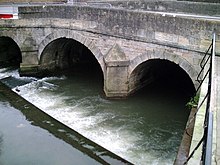
Since 2002, there have been plans in place to redevelop significant town centre sites. Trowbridge Community Area Future (TCAF) produced a Community Area Plan in 2004, to guide future development.
In the early 1990s the supermarket chain Tesco moved from St Stephen's Place to a site adjoining the A361 on County Way, and their former site remained dormant for a decade. The building was demolished but a pile of rubble, nicknamed 'Mount Crushmore' by local media, remained. Legal & General acquired the land and construction of St Stephen's Place Leisure Park began in 2012. A seven-screen Odeon cinema and Nando's restaurant opened in October 2013. A Premier Inn and food outlets including Frankie and Benny's and Prezzo followed in 2014.
The former Usher's brewery site has also undergone redevelopment over a number of years, with Newland Homes building town centre flats incorporating the frontage of the Usher's building.
In April 2009, building work started on one of the town's biggest brownfield sites, the former Usher's bottling plant. This was developed into a Sainsbury's supermarket, a public square and housing.
Architecture
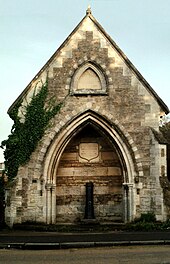
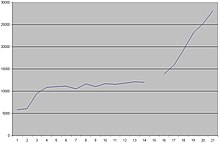
There is much of architectural interest in Trowbridge, including many of the old buildings associated with the textile industry, and the Newtown conservation area, a protected zone of mostly Victorian houses. The town has six Grade I listed buildings, namely St James's Church, Lovemead House on Roundstone Street, and numbers 46, 64, 68 and 70 Fore Street. The latter is referred to more commonly as Parade House.
Trowbridge Town Hall is in Market Street, opposite the entrance to the now-pedestrianised Fore Street. This three-storey building with an Italianate clock-tower was presented to the residents of the town by a local mill-owner, Sir William Roger Brown, in 1889 to celebrate Queen Victoria's golden jubilee. The building was the seat of local government until 1974 and subsequently accommodated the magistrates' courts until 2003. More recently it has been used for exhibitions and community events.
Governance
The Town Council is the first tier of local government and is composed of 21 councillors.
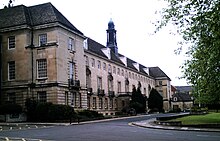
County Hall in Bythesea Road, Trowbridge, is the administrative centre for Wiltshire Council, a unitary authority created in April 2009 which replaced both West Wiltshire District Council and the former Wiltshire County Council, also headquartered at County Hall since 1940. Trowbridge civil parish is divided into seven electoral divisions, each electing one member of Wiltshire Council.
Trowbridge is within the South West Wiltshire parliamentary constituency, which has been represented by Andrew Murrison (Conservative) since its formation in 2010.
Geography
The River Biss enters Trowbridge from the southeast, where it flows through Biss Meadows, managed as a country park. In the north of the town it is joined by the Lambrok Stream, then continues north to join the River Avon near Staverton.
Northwest of the town, part of the Avon Green Belt prevents expansion towards Bradford-on-Avon. To the north and northwest, housing areas in Staverton and Hilperton parishes are contiguous with Trowbridge's urban area; however, to the south and southeast, the villages of Southwick, North Bradley, Yarnbrook and West Ashton maintain their separate identities.
Demography
The first official census of 1801 showed Trowbridge having 5,799 inhabitants, which rose sharply to 9,545 in 1821. The population rose by less than 50% in the 130 years to 1951, compared to a considerably larger increase in the population of the country as a whole. From 1951 to 2011, the population increased by 133%. Coinciding with this increase, a considerable conversion of arable fields and some riverside meadows to residential estates took place.
| Year | 1801 | 1811 | 1821 | 1831 | 1841 | 1851 | 1881 | 1891 | |
|---|---|---|---|---|---|---|---|---|---|
| Population | 5,799 | 6,075 | 9,545 | 10,863 | 11,050 | 11,148 | 11,040 | 11,717 | |
| Year | 1901 | 1911 | 1921 | 1931 | 1951 | 1961 | 2001 | 2011 | 2021 |
| Population | 11,526 | 11,815 | 12,130 | 12,011 | 13,859 | 15,844 | 28,163 | 32,304 | 37,169 |
According to the census in 2011, the ethnic breakdown of the population of Trowbridge parish was: White 94.8%, Mixed/multiple ethnic groups 1.9%, Asian/Asian British 1.5%, Black/African/Caribbean/Black British 1.1%, Other ethnic group 0.8%. The population of the built-up area, which includes Staverton and Hilperton parishes, was 39,409 in 2011 and was estimated to have grown to 43,719 by mid-2020.
In 2018 the Office for National Statistics estimated the population of the larger "community area" at 45,822, making Trowbridge the most populous area in Wiltshire (excluding Swindon), with Chippenham close behind in second place and Salisbury third. At the 2021 Census, the population of the "built-up area" – consisting of Trowbridge, Staverton and Hilperton parishes – was 43,744.
Transport
Trowbridge railway station was opened in 1848 on the Westbury–Bradford-on-Avon section of the Wilts, Somerset and Weymouth Railway. Today this line forms part of both the Wessex Main Line (Bristol–Westbury–Southampton) and the Heart of Wessex Line (Bristol–Westbury–Weymouth), while the original route to Melksham, Chippenham and Swindon is used by the TransWilts service. Other services from Trowbridge join the Great Western Main Line at Bath and Chippenham, or join the Reading to Taunton line at Westbury.
Trowbridge is about 18 miles (29 km) from junction 17 of the M4 motorway at Chippenham. The A361 runs through the town, connecting it to Swindon to the north-east and Barnstaple to the south-west, while the north–south A350 primary route to Poole passes close to the town.
The nearest airport is Bristol Airport, which is 30 miles (48 km) west.
Education
Primary schools in the town include Bellefield Primary School, The Grove Primary School, Holbrook Primary School, Oasis Academy Longmeadow, Paxcroft Primary School, The Mead Community Primary School, Newtown Primary School, Castle Mead School, St John's Catholic Primary School, Studley Green Primary School and Walwayne Court Primary School. Children may also attend schools in adjacent parishes including North Bradley CE Primary School, Hilperton CE Primary School and Staverton CE Primary School.
Secondary schools in Trowbridge are the Clarendon Academy, the John of Gaunt School and St Augustine's Catholic College. All of the secondary schools also operate their own sixth forms. Larkrise School is a special school for children aged 3 to 19.
Wiltshire College has one of its four campuses in Trowbridge offering a range of vocational courses for school-leavers.
Healthcare
Trowbridge Cottage Hospital, now Trowbridge Community Hospital was opened in 1870.
Shopping and entertainment
The town centre is compact, and the focus for shops is the ancient Fore Street; the more modern Shires, Shires Gateway and Castle Place shopping centres provide a variety of outlets.
The civic centre, opened in 2011 and next to the town's central park, is a conference and entertainment venue and is home to the town's information centre as well as Trowbridge Town Council. A nearby leisure development includes an Odeon cinema and several food vendors (Wagamama, Nando's etc.).
The former Town Hall, a large Victorian building, is a performance and exhibition venue and is also used by community groups. At Wiltshire College the Arc Theatre is used by students and local groups. There is a concert hall at Wiltshire Music Centre in neighbouring Bradford-on-Avon.
Trowbridge is part of the historic West Country Carnival circuit. There is an annual multi-day folk music festival called Trowbridge Festival, formerly Trowbridge Village Pump Festival; the 2024 edition was held at Southwick, near Trowbridge.
Notable people

Methodism was introduced to the town by local evangelist Joanna Turner in the 18th century. Trowbridge was the birthplace of Sir Isaac Pitman in 1813, developer of the Pitman system of shorthand writing, who has several memorial plaques. Matthew Hutton (later archbishop of Canterbury) was the town's rector from 1726 to 1730. The poet George Crabbe held the same position from 1814 until his death in 1832.
Mary Mortimer, born in Trowbridge in 1816, became an American educator. Sir William Cook, born in Trowbridge in 1905, was involved with the development of the British nuclear bomb at Aldermaston in the 1950s, becoming the establishment's deputy director.
Sir William Roger Brown (1831–1902), a Trowbridge mill-owner, employed more than a thousand people and donated a school, almshouses, and the Trowbridge Town Hall to the town.
David Stratton, the film critic was born in Trowbridge in 1939. He founded the Melksham and District Film Society before emigrating to Australia in 1963, where he ran the Sydney Film Festival for 17 years, as well as presenting the film review shows The Movie Show on SBS and At The Movies on the ABC.
Nick Blackwell, professional boxer and former British middleweight champion, is from Trowbridge, as are footballer Nathan Dyer (who played for Leicester City in the 2015-16 season when they won the Premier League), disgraced snooker player Stephen Lee, and Daniel Talbot, winner of the 4 × 100 m relay at the 2017 World Athletics Championships in a time of 37.47sec – the third fastest time in history.
The Oliver Twins, who created the Dizzy series of games amongst others, and in 1990 founded Interactive Studios (later Blitz Games), grew up in Trowbridge. A building at the Clarendon Academy is named after the brothers.
Dick Lucas, founding member and main vocalist of punk rock band Subhumans was born in Trowbridge.
Tom Gale, high jumper who represented Great Britain at the 2020 Tokyo Olympics; went to school in Trowbridge.
Sport and leisure
The town has a non-league football club, Trowbridge Town F.C., who play at Woodmarsh to the south of the town, near North Bradley.
Trowbridge Cricket Club play at Trowbridge Cricket Club Ground which is also used by Wiltshire County. The town's 1st XI play in the Wiltshire division of the West of England Premier League.
Trowbridge Rugby Football Club, whose ground is at Hilperton to the northeast of the town, play in Southern Counties South.
Trowbridge Sports Centre, on the same site as The Clarendon Academy, has the town's only indoor swimming pool.
A greyhound racing track was opened around the Frome Road ground used by Trowbridge Town F.C. from 3 July 1976 until July 1979. The racing was independent (not affiliated to the sports governing body the National Greyhound Racing Club) and was known as a flapping track, which was the nickname given to independent tracks. A series of meetings were also held during 1953.
Town twinning
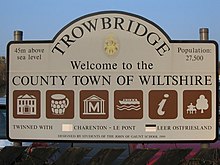
Trowbridge is twinned with four towns: Oujda, the area of Morocco where most of the town's immigrant population originate, since 2006; Leer in Germany, since 1989; Charenton-le-Pont in France since 1996; and Elbląg in Poland, as part of West Wiltshire district twinning, since 2000. The town was the first in England to twin with an Arab Muslim country.
See also
References
- ^ "Trowbridge: population statistics, 2021 Census". CityPopulation.de. Retrieved 26 April 2023.
- "Trowbridge". Wiltshire Community History. Wiltshire Council. Retrieved 4 March 2011.
- Town Official Guide, Trowbridge Town Council, 2008
- ^ Origins of the name Trowbridge: Strum.co.uk website. Retrieved on 25 January 2008.
- Lewis, Harold (1978). The Church Rambler, Volume 2. Hamilton, Adams & Co. pp. 199–226.
- Trowbridge in the Domesday Book
- First mention of Trowbridge Castle Archived 28 August 2008 at the Wayback Machine: Local Authority Publishing website. Retrieved on 25 January 2008.
- ^ Pugh, R.B.; Crittall, Elizabeth, eds. (1953). "Victoria County History: Wiltshire: Vol 7 pp125-171 - Parishes: Trowbridge". British History Online. University of London. Retrieved 11 May 2017.
- Graham, Alan H., and Susan M. Davies (1993). Excavations in Trowbridge, Wiltshire, 1977 and 1986–1988: The Prehistoric, Saxon, and Saxo-Norman Settlements and the Anarchy Period Castle. Salisbury: Wessex Archaeology. p. 1.
- Crittall, Elizabeth, ed. (1959). "The woollen industry before 1550". A History of the County of Wiltshire, Volume 4. Victoria County History. University of London. pp. 115–147. Retrieved 28 March 2022 – via British History Online.
- Jeff Horn (Spring 2005). "Machine-breaking in England and France during the Age of Revolution". Labour / Le Travail. 55. Canadian Committee on Labour History: 143–166. JSTOR 25149563.
- "Economic History". Trowbridge Town Council. Archived from the original on 10 April 2008. Retrieved 16 March 2008.
- The Trowbridge Woollen Industry as Illustrated by the Stock Books of John and Thomas Clark, 1804–1824, John Clark & Thomas Clark & R. P. Beckinsale, Wiltshire Record Society/Biddles Ltd, 1973.
- "Wiltshire History Questions". Wiltshire Council. 26 April 2007. Retrieved 8 November 2010.; another example is at Bowlish near Shepton Mallet.
- "Wiltshire Community History Questions". Wiltshire Council. Retrieved 7 May 2011.
- "How Ushers' Trowbridge brewery is now the toast of North Korea". Wiltshire Times. 5 July 2009. Retrieved 21 November 2009.
- "Kim Jong-ale: How did Ushers brewery of Trowbridge end up in North Korea producing Pyongyang's number one beer - and what did it take to set up a taste test back in Wiltshire?". independent.co.uk. 18 April 2014. Retrieved 8 October 2016.
- Redevelopment plans Archived 16 June 2008 at the Wayback Machine (since 2002): Transforming Trowbridge website. Retrieved on 25 January 2008.
- "Trowbridge Community Area Plan". Trowbridge Town Council. Archived from the original on 20 August 2010. Retrieved 26 August 2010.
- Ushers Brewery site, proposed plans for redevelopment: Wiltshire Times website. Retrieved 25 January 2008.
- Baker, John (7 June 2022). "Leo the Jubilee Lion launched outside historic house". Wiltshire Times. Retrieved 30 September 2022.
- Historic England. "Town Hall (1364209)". National Heritage List for England. Retrieved 11 May 2017.
- "Magistrates' courts to close". BBC. 10 June 2003. Retrieved 1 April 2021.
- ^ "Town Hall Arts". Trowbridge Arts. Archived from the original on 20 October 2019 – via Internet Archive.
- "Councillors". Trowbridge Town Council. Retrieved 20 July 2024.
- "Election Maps: Great Britain". Ordnance Survey. Retrieved 20 July 2024.
- "Your Councillors". Wiltshire Council. Retrieved 20 July 2024.
- "Country parks and open spaces". Wiltshire Council. Retrieved 27 August 2020.
- "River Biss". Catchment Data Explorer. Environment Agency. Retrieved 27 August 2020.
- "Wiltshire Core Strategy - Adopted January 2015" (PDF). Wiltshire Council. pp. 15, 84. Archived from the original (PDF) on 2 September 2018.
- "Election Maps". Ordnance Survey. Retrieved 27 August 2020.
- ^ "Census: Trowbridge". Wiltshire Community History. Wiltshire Council. Retrieved 5 June 2015.
- "Local Area Report for Trowbridge Parish". Nomis (Office for National Statistics). Retrieved 26 January 2021.
- "Trowbridge (E35000362)". City population. Retrieved 25 October 2022.
- "Community area population estimates". Wiltshire Council. Retrieved 6 December 2019.
- "Trowbridge built-up area: population statistics, 2021 Census". CityPopulation.de. Retrieved 26 April 2023.
- "The John of Gaunt School". The John of Gaunt School. Retrieved 15 August 2016.
- "Clarendon Academy". Clarendon Academy. Retrieved 15 August 2016.
- "St Augustine's Catholic College". St Augustine's Catholic College. Retrieved 15 August 2016.
- "Larkrise School". Larkrise School. Retrieved 15 August 2016.
- "Trowbridge campus". Wiltshire College. Archived from the original on 16 August 2016. Retrieved 15 August 2016.
- "Trowbridge Postcards & Ephemera"". Flikr.com. 8 April 2024. Retrieved 8 April 2024.
- "The Civic Centre". Trowbridge Town Council. 2011. Archived from the original on 25 August 2011.
- "Arc Theatre". Wiltshire College. Retrieved 19 December 2018.
- Baker, John (27 January 2024). "Carnival 'may not be able to continue' as urgent appeal launched to save it". Wiltshire Times. Retrieved 31 October 2024.
- Baker, John (26 July 2024). "All you need to know ahead of 50th anniversary festival this weekend". Wiltshire Times. Retrieved 31 October 2024.
- Sir Isaac Pitman, born in Trowbridge: NNDB website. Retrieved on 25 January 2008.
- Matthew Hutton, Archbishop of Canterbury Archived 7 January 2008 at the Wayback Machine, town's rector: Troweb website. Retrieved on 25 January 2008.
- George Crabbe, poet Archived 27 October 2003 at the Wayback Machine and rector of Trowbridge: Britain Unlimited website. Retrieved on 25 January 2008.
- Sir William Cook KCB Kt FRS Archived 6 October 2008 at the Wayback Machine, notable resident: Local Authority Publishing website. Retrieved on 25 January 2008.
- "Sir William Roger Brown" in The Wiltshire Archaeological and Natural History Magazine (1902), p. 230
- "SIR WILLIAM ROGER BROWN" in Arthur Charles Fox-Davies, Armorial Families (1895), p. xxxiv
- ^ "David Stratton". www.penguin.com.au. Retrieved 11 October 2021.
- "David Stratton documentary to offer a star-studded portrait of a very private man". the Guardian. 24 January 2017. Retrieved 11 October 2021.
- "Nathan Dyer: Leicester sign Swansea winger on loan". BBC Sport. BBC News. 1 September 2015. Retrieved 7 February 2017.
- Keogh, Frank (25 September 2013). "Stephen Lee: Snooker player given 12-year ban for match-fixing". BBC Sport. BBC News. Retrieved 3 June 2016.
- "News :: Archive :: Oliver Twins honoured with naming of school building". Blitz Games Studios. 12 September 2013. Retrieved 8 October 2016.
- "Tokyo 2020: Bath-born high jump star Tom Gale proud to be representing Team GB and Team Bath on the Olympics stage". University of Bath/Teambath. 22 July 2021. Retrieved 2 January 2024.
- "Trowbridge Sports Centre". Places for People Leisure. Retrieved 20 March 2018.
- Barnes, Julia (1988). Daily Mirror Greyhound Fact File, page 419. Ringpress Books. ISBN 0-948955-15-5.
- "Trowbridge Greyhound Stadium". Greyhound Racing Times.
- "Understanding Muslim Ethnic Communities – The Moroccan Muslim Community in England" (PDF). Change Institute. Communities and Local Government. April 2009. Archived from the original (PDF) on 26 August 2012.
- ^ "Trowbridge – Market town twins with Arab city". BBC News. BBC News Channel. 3 October 2006. Archived from the original on 21 October 2007. Retrieved 1 August 2013.
- "British towns twinned with French towns [via WaybackMachine.com]". Archant Community Media Ltd. Archived from the original on 5 July 2013. Retrieved 20 July 2013.
- "Backing For Link To Morocco (from Wiltshire Times)". wiltshiretimes.co.uk. 22 September 2006. Retrieved 28 July 2008.
External links
 Trowbridge travel guide from Wikivoyage
Trowbridge travel guide from Wikivoyage- Trowbridge Town Council
- Trowbridge history (Wiltshire Council)
- Out and about in Trowbridge – Ken Rogers, The Historian, Summer 2010 pp. 28–31
| Ceremonial county of Wiltshire | |
|---|---|
| Unitary authorities | |
| Major settlements (cities in italics) | |
| Rivers | |
| Canals | |
| Topics | |